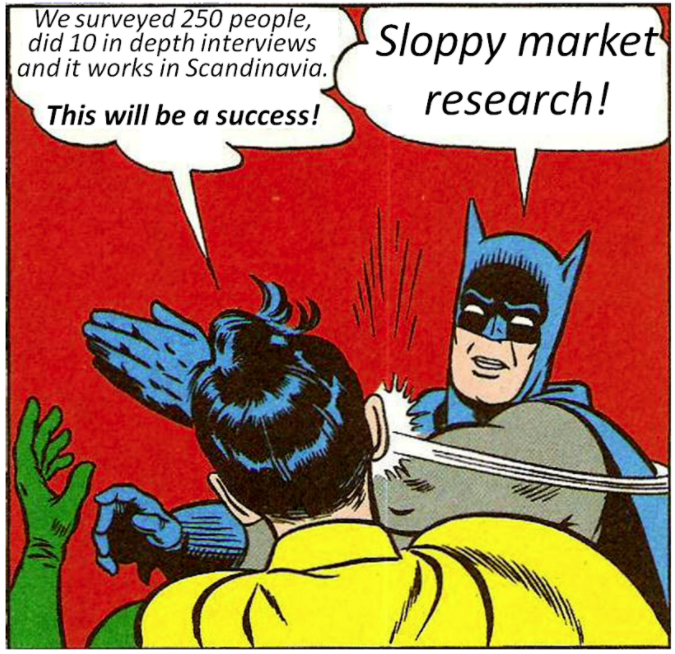Physical Address
304 North Cardinal St.
Dorchester Center, MA 02124

This month we’ve been sharing our thoughts on starting a business: the first step to starting a business, how to figure out if you can money with your idea, and whether or not its the kind of idea that you can execute.
But even if you’ve gone through all of those steps, you still don’t have a business. You have an idea. And if you can’t get people to pay for it, you have nothing.
So this post will talk how to test your idea—or what some experts have called finding product / market fit.
Ask Your Network for Feedback
This is where a lot of would-be entrepreneurs wanting to start a business tell their friends and family about their idea and ask what they think.
Not surprisingly, most of them say, “Yeah, that’s a great idea. You should definitely start that business.” Or, “I would definitely buy that.”
Now you’ve got the validation you were looking for. So you open up for business. And if you’re really lucky, you succeed. But we wouldn’t bet on it.
Even if everyone tells you they like your idea and would buy it, you don’t have a good business until people pull out their wallets and pay for your product.
 Take, for example, Michal Bohanes, who had a great idea: people will pay for the convenience of a ready-to-fix meal, delivered to their home. It’s just the kind of thing busy moms and dads would pay for, right? 70% of the 250 people he surveyed said they would pay for that service. In-depth interviews showed people loved the idea. So Bohanes created a website and launched Dinnr.
Take, for example, Michal Bohanes, who had a great idea: people will pay for the convenience of a ready-to-fix meal, delivered to their home. It’s just the kind of thing busy moms and dads would pay for, right? 70% of the 250 people he surveyed said they would pay for that service. In-depth interviews showed people loved the idea. So Bohanes created a website and launched Dinnr.
He was in business. In the first week, he sold 12 orders. They hit a high of 23 orders on Valentine’s Day. But things never took off.
It turns out Bohanes wasn’t solving a problem that customers really cared about. Even though a lot of people told him they like it. (Read that link above. It’s worth your time.) There was no real pain point he was solving.
So go ahead and ask your friends and family what they think. But don’t believe what they tell you.
Validating Your Idea with Actual Customers
To find out if your idea is commercially viable (will people buy it?), don’t ask customers if they would buy, ask them to buy. There are a couple of ways to validate your idea with potential customers. Entire books have been written about this single step in starting a business.
How to Test Your Idea with Adwords
The first way to test your idea in the “real” world is to set up a website or landing page that features your product or service. You don’t need to spend a lot of money on its creation, but it does need to look professional—remember you want anyone who visits the site to see that your new startup is trustworthy. But you don’t need to pay thousands of dollars to get up and running. This is a test. So a good website template (Unbounce and Leadpages are both good options, or WordPress if you want a multipage site) and an inexpensive but professional looking logo design will be enough for now.
Next you’ll need to set up an Adwords account and deposit $100-200 (If you use Bluehost to host your site, you should be able to get an Adwords coupons for $75-100 to get you started). Once you’ve set up your account and written an ad with your product offer and a link to your landing page, set the bidding option to Automatic Bidding and Maximize Clicks. Also, set your geographic area to your own country or state. Google may recommend a bid target, set yours a bit below the recommendation and see what happens. If you don’t get any clicks after a few hours, raise the bid by 10-15¢. Repeat this process until you see clicks start to come in.
Next, set up conversion tracking in Adwords (and paste the script onto your conversion page so you can track how the ad does). The Adwords process can get pretty complex, but for this test we just need the basics. An ad set to run for specific keywords that your customers are searching online and the code that tracks who buys.
Now watch your webpage and your Adwords account. If your product idea appeals to the people who click on your ad, you should be able to sell on your site. If you don’t have a finished product, you should be able to collect contact information for interested customers who want to hear back when you launch.
For a more in-depth primer on how to test with Adwords, check out Tim Ferriss’ book, The 4-Hour Workweek (Chapter 10).
A few Cautions with this Approach:
If you are only collecting email addresses rather than selling your product, you don’t really know if customers will pay for your offer. You only know they are interested. This can be indicative of success, but like Dinnr, it can be misleading. It’s best to ask for the buy.
Second, if you choose the wrong search terms or create a poorly performing landing page, this can affect your results negatively and you won’t know if your product meets a market need. Working with someone who has been through the process before to make sure you get the results you are looking for, may be worth the money.
Or, if you already have your product or service, you can try this…
 Launch Your Product and Iterate Fast
Launch Your Product and Iterate Fast
Some ideas are so simple that it’s actually just as time consuming to set up a web page and Adwords campaign as it is to set up the actual product website. This was the case for 7 Day Startup author Dan Norris, who got his business up and running, with paying customers, in less than seven days.
The key is to launch and iterate quickly. Create your product and get it out there. Launch a small Adwords campaign, pitch to your email list, or use some other way to get the word out (yes, this is harder than I’m making it sound). Ship. Then improve it as you go.
That’s the path that Shayna McHugh, founder of Espresso English, has followed with some of her ebooks and courses. On at least one occasion, she pitched a course to her email list, then when several customers signed up, she had to produce a new lesson every day until the course was completed. She sold the course first, and was paid to create the product for her customers (you can hear her talk about it here).
A Caution with the Launch and Iterate Approach:
Once you build a particular product, it’s very easy to get stuck trying to make it work, even if it doesn’t solve a market problem. You figure you’ll try just one more idea. You just need to get it in front of the right customers. And so you spin your wheels on an idea that isn’t going anywhere. As Kauffman Fellow, Paul Kedrowsky, once said, “Once you build something you are dead.”
Launch Your Business as a Service
If your product isn’t ready or you don’t have the money to build it, you can always launch your business as a service and take on customers who will help pay to develop the product as you work for them.
This might work for someone developing a niche software product. You get hired by a company that needs that product or service, and in the process of doing it for them, you build your product to the specifications of your first customer (your employer). There are some potential legal issues with this approach, if you’re not careful. You may also find that you spend all of your time providing the service, and none creating your product. However, it is a viable way to start a business, create your product, and test it in a real world situation.
As Paul Ahlstrom and Nathan Furr wrote in their fantastic book, Nail It, Then Scale It, “The greatest mystery to entrepreneurs is not the invention—it is the market insight that leads to innovation and market adoption.”
When you start a business, it is critical to figure out if the market will adopt your idea. If it won’t, start looking for a new one.
Photo credit: NASA